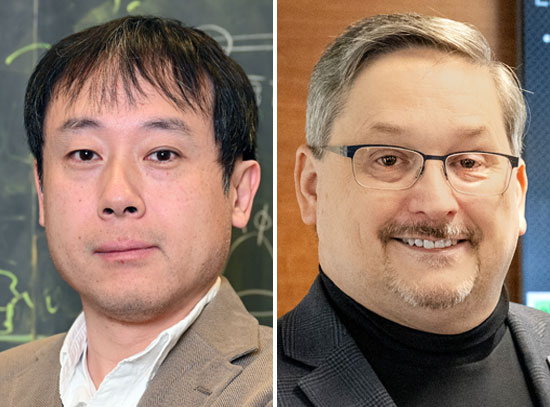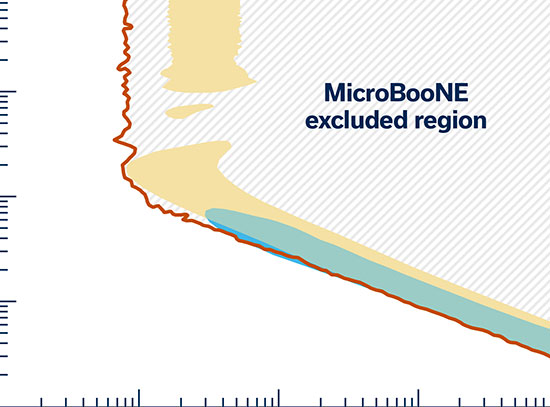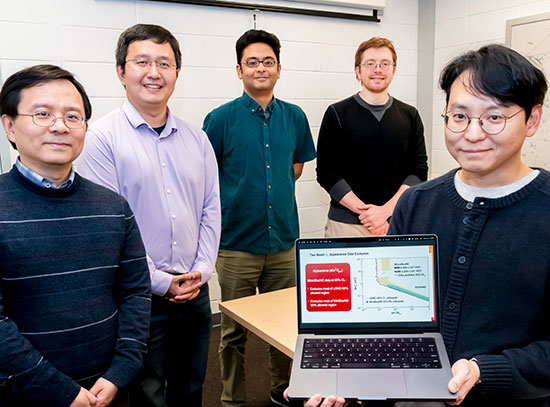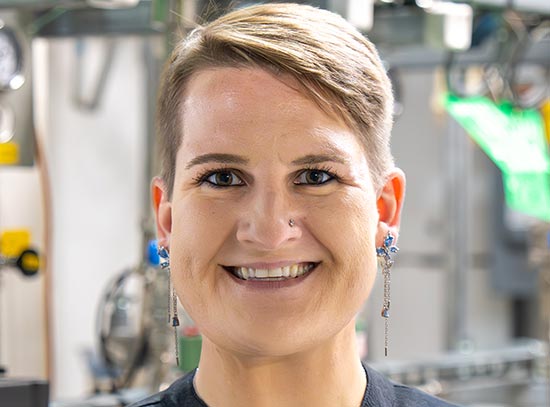Spintronics in a 2D Intermetallic Material
November 30, 2024
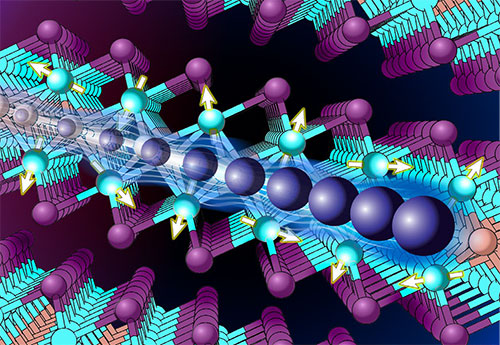 enlarge
enlarge
In CeSiI, the coupling of itinerant electrons (blue spheres) and localized magnetic moments (yellow arrows) creates quasiparticles with dramatically enhanced effective mass, called heavy fermions. Credit: Nature 625, 483-488 (2024).
The Science
Researchers found electrons coupled to magnetism in the 2D "intermetallic" cerium silicon iodide (CeSiI).
The Impact
CeSiI established as a platform for studying coupled electronic & magnetic interactions in these materials, with an eye on potential spintronics applications.
Summary
An international collaboration of researchers has successfully synthesized the first 2D heavy fermion material, a layered intermetallic crystal composed of cerium, silicon, and iodine (CeSiI). Heavy fermion materials have attracted the interest of physicists due to the interesting electronic and magnetic properties effects they display.
Heavy fermion materials are traditionally three-dimensional intermetallic structures. Researchers have sought ways to create a dimensional reduction in these materials so that they can exert more control and tunability over their behaviors.
In this study, the material under investigation is cerium silicon iodide (CeSiI), which has a layered structure consisting of ultrathin, 2D metallic sheets that are loosely bound together by a weak electronic force known as the van der Waals effect. This structure effectively confines the electrons within it to a 2D plane.
The researchers discovered that CeSiI displays heavy fermion behavior and ordered magnetic states down to the ultra-thin regime — the thinnest part of the sample — approaching the 2D theoretical limit. They used a variety of techniques, including thermodynamics studies, microscopy, and angle-resolved photoemission spectroscopy (ARPES). The ARPES work was performed at the Electron Spectro-Microscopy beamline at National Synchrotron Light Source II (NSLS-II). NSLS-II is a U.S. Department of Energy (DOE) Office of Science user facility located at DOE's Brookhaven National Laboratory.
The study shows that CeSiI and similar materials can be used as model systems to study dimensionally confined heavy fermions, allowing scientists to probe electronic behaviors at microscopic length scales and exploring ways to tune these systems, perhaps even leading to the emergence of superconductivity.
Download the research summary slide (PDF)
Contact
Angel Rubio
Max Planck Institute for the Structure and Dynamics of Matter
angel.rubio@mpsd.mpg.de
Michael Ziebel
Columbia University
mez2127@columbia.edu
Andrew Millis
Columbia University
ajm2010@columbia.edu
Abhay Pasupathy
Columbia University
apn2108@columbia.edu
Xavier Roy
Columbia University
xr2114@columbia.edu
Publications
Victoria A. Posey, Simon Turkel, Mehdi Rezaee, Aravind Devarakonda, Asish K. Kundu, Chin Shen Ong, Morgan Thinel, Daniel G. Chica, Rocco A. Vitalone, Ran Jing, Suheng Xu, David R. Needell, Elena Meirzadeh, Margalit L. Feuer, Apoorv Jindal, Xiaomeng Cui, Tonica Valla, Patrick Thunstrom, Turgut Yilmaz, Elio Vescovo, David Graf, Xiaoyang Zhu, Allen Scheie, Andrew F. May, Olle Eriksson, D. N. Basov, Cory R. Dean, Angel Rubio, Philip Kim, Michael E. Ziebel, Andrew J. Millis, Abhay N. Pasupathy, Xavier Roy. "Two-dimensional heavy fermions in the van der Waals metal CeSiI." Nature volume 625, pages 483-488 (2024). DOI: 10.1038/s41586-023-06868-x
Funding
Research on 2D heavy-fermion materials was primarily supported by the US Department of Energy (DOE), Office of Science, Basic Energy Science, under award DE-SC0023406. ARPES measurements were performed at Beamline 21-ID-1 of the National Synchrotron Light Source II, a DOE Office of Science User Facility operated for the DOE Office of Science by Brookhaven National Laboratory (Contract No. DE-SC0012704). We thank C. Petrovic and Z. Hu for their help with the sample mounting for ARPES. High-magnetic-field transport and tunnel diode oscillator measurements were performed at the National High Magnetic Field Laboratory, which is supported by the National Science Foundation (NSF; Cooperative Agreement No. DMR-1644779) and the State of Florida. Subkelvin specific heat capacity measurements (A.F.M.) were supported by the DOE, Office of Science, Basic Energy Sciences, Materials Sciences and Engineering Division. The specific heat analysis used resources at the Spallation Neutron Source, a DOE Office of Science User Facility operated by the Oak Ridge National Laboratory. The PPMS used to perform vibrating-sample magnetometry, heat capacity and electrical transport measurements was purchased with financial support from the NSF through a supplement to award DMR-1751949. STM equipment support was provided by the Air Force Office of Scientific Research via grant FA9550-21-1-037. Electrical transport measurements of low-dimensional samples were supported by the NSF (DMR-2105048). Nano-imaging experiments and theoretical modelling were supported as part of Programmable Quantum Materials, an Energy Frontier Research Center funded by the DOE, Office of Science, Basic Energy Sciences (Award DE-SC0019443). The theory calculations by O.E., P.T. and C.-S.O. were supported by an ERC synergy grant (FASTCORR, project 854843), the Swedish Research Council, eSSENCE, STandUPP and the Wallenberg Initiative Materials Science for Sustainability (WISE) funded by the Knut and Alice Wallenberg Foundation (KAW), the Swedish National Infrastructure for Computing, Grupos Consolidados (IT1453-22), and the German Research Foundation through the Cluster of Excellence CUI: Advanced Imaging of Matter (EXC 2056, project ID 390715994) and Project SFB-925 Light-induced Dynamics and Control of Correlated Quantum Systems (Project 170620586). V.A.P. is supported by the NSF Graduate Research Fellowship Program (NSF GRFP 2019279091). A.D. acknowledges support from the Simons Foundation Society of Fellows programme (Grant No. 855186). We acknowledge the use of facilities and instrumentation supported by the NSF through the Columbia University, Materials Research Science and Engineering Center (Grant No. DMR-2011738). The Flatiron Institute is a division of the Simons Foundation. We acknowledge support from the Max Planck–New York City Center for Non-Equilibrium Quantum Phenomena.
2024-22226 | INT/EXT | Newsroom





